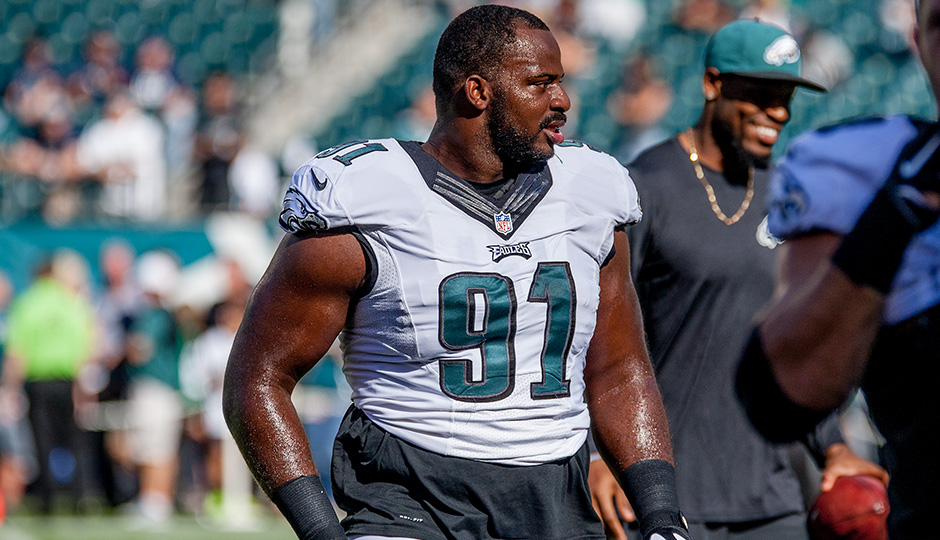Eagles Weekend Reading: Future Considerations
Hope everyone is enjoying this Halloween weekend. Some links to pass along for your reading pleasure:
Domo talked to Joe Banner, who says the Eagles have some financial decisions to make when it comes to their defense.
The Eagles picked up Cox’s option for 2016, which means that unless he signs a new contract, his salary-cap number will jump from $3.3 million this year to $7.8 million next year.
As things stand now, he will be one of seven defensive players with a cap number of at least $4 million next year. The others are cornerback Byron Maxwell ($9.7M), linebacker Connor Barwin ($7.3M), safety Malcolm Jenkins ($7.2M), linebacker Brandon Graham ($5M) and linebackers Mychal Kendricks ($4.6M) and Ryans ($4.5M).
“Clearly, the amount of money that they need to spend if they want to keep the guys up front in place will have an impact on how much they can spend on the guys on the back end,” said former Eagles president Joe Banner, who now has a studio gig with ESPN.
“They can’t have all big-money guys. They can’t have Kendricks and DeMeco Ryans and then three high-priced guys up front and two expensive corners and a safety. They’d have to play with all rookies on offense if they did that. So they’re going to have to make some choices.”
Mike Sando of ESPN.com thinks there is a “high” chance of Sam Bradford being in a different uniform next season:
Bradford ranks 32nd (last) in Total QBR among qualifying quarterbacks this season. He ranks 28th out of 30 qualifiers since entering the league in 2010.
“I don’t know Sam at all, but I think eventually when you are in the league, you are what you are,” a player from another team said before the 2014 season. “This is what, five years for him?”
It’s Year 6 now, and Bradford is seven games into his return from a second torn ACL. Arizona Cardinals coach Bruce Arians has said evaluating quarterbacks in new systems becomes viable after about eight games. Bradford and the Eagles have a bye this week before visiting Dallas for their eighth game.
“I can see someone signing Bradford if he stays healthy all year,” one of the GMs said, “and I could see the Eagles just letting him go.”
Chris Wesseling of NFL.com has Jordan Hicks ranked 10th on his Rookie of the Year Watch, behind Todd Gurley, Amari Cooper, Bills corner Ronald Darby, Leonard Williams, Vikings receiver Stefon Diggs, Jameis Winston, Eric Kendricks, Colts defensive end Henry Anderson and Marcus Mariota.
10. Jordan Hicks, Philadelphia Eagles linebacker: Chip Kelly’s offseason machinations have backfired with Sam Bradford, DeMarco Murray and Byron Maxwell failing to meet expectations. His first two draft picks — Nelson Agholor and Eric Rowe — have also disappointed. Hicks and Ryan Mathews are the bright spots.
Jeff McLane takes a close look at the Birds at the bye, and names his MVPs on both the offensive and defensive side of the ball:
Offense – Ryan Mathews
It’s an ominous sign when your most valuable player has played only 26 percent of the snaps. But Mathews has been the one skill position player on offense to exceed expectations this season. The running back rushed for over 100 yards when an injured DeMarco Murray missed the New York Jets game, and he averaged 7.3 yards per carry in spot duty in the six other games. Chip Kelly has done a questionable job of getting Mathews, who appears to have better physical skills than Murray, more involved in the offense. When both have been active, Murray has averaged 4.0 yards per touch and Mathews 7.4 yards.
Defense – Fletcher Cox
Everything starts up front, to repeat a commonly used phrase, and it’s no truer than with Cox and the Eagles. The end has been the anchor of a defensive line that has arguably been the team’s best unit over the last two years. Cox leads the Eagles with five sacks and three forced fumbles and has been just as disruptive a pass rusher as he has been against the run. Defensive tackle Bennie Logan deserves a nod for his improved play, particular on run downs.
Kevin Clark of the Wall Street Journal writes that the NFL isn’t exactly putting out a high-quality product at the moment, and examines why.
Anecdotally, coaches and executives admit that offensive line play has never been worse. That is not backed up by much data—the league’s quarterback sack numbers haven’t risen dramatically this season—but simply watching on Sundays seems to confirm that something is amiss. Beyond doubt is the fact that referees think teams are more mistake-prone. Penalties have shot up from 12.6 per game in 2011 to 14.80 a game this season. This has created games with endless stops and starts, or worse, for the Buffalo Bills—whose 670 penalty yards are 137 more than anyone else in the league—games that are only stops, no starts.
Coaches point to the collective bargaining agreement that, when signed in 2011, limited practice time, which they say has hurt young players’ development. A movement for some sort of off-season league or changes to the practice structure is growing behind the scenes, but it would take more than a couple of extra practices to clean up all the errors seen this season.
If you ask people around the league why the quality of play has dropped so far, you’ll get enough answers to fill a playbook. One theory: the league is struggling to come to terms with a blitz of rapid rules changes. Laws to protect player safety have made building a team with “smash-mouth” tendencies harder than ever. This has created problems for hard-nosed coaches, whose physical approach no longer fits in an era where referees police illegal hits closer than ever.
